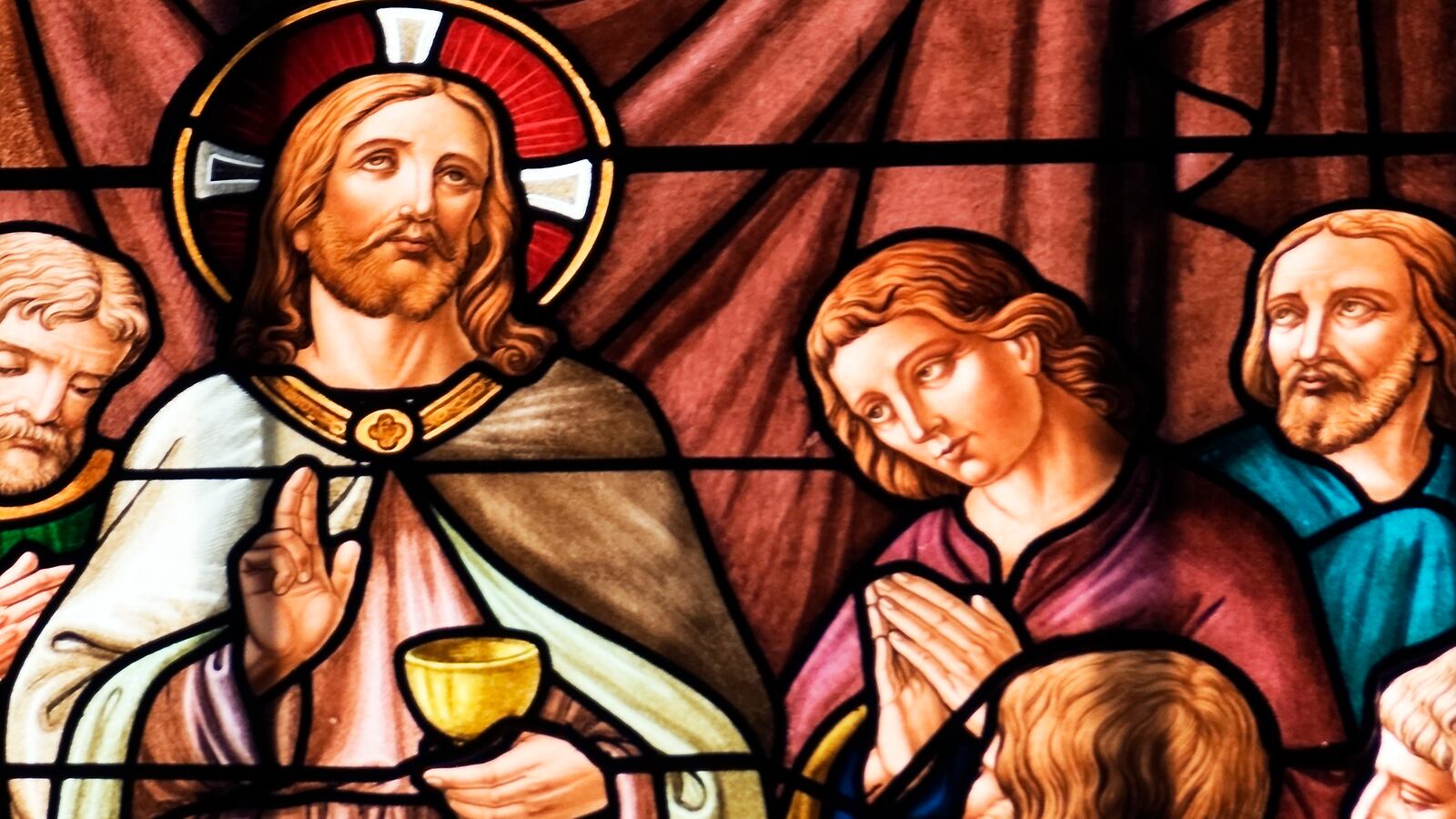This coming Easter Sunday, millions of Catholics around the world will celebrate Jesus’ resurrection from the dead. But some worshippers celebrating Mass in the San Francisco Bay Area will have a spiritual connection closer to death than others: They will be drinking sacramental wine made from grapes grown in cemeteries.
About 24 churches in the Roman Catholic Diocese of Oakland will use wine for Mass made from grapes grown in three East Bay cemeteries. The altar wine, bottled under the Bishop’s Vineyard label, is the result of an experiment driven by economics and California’s long drought. Instead of planting grass over bare spots in the cemeteries at a cost of $50,000 an acre, the diocese decided instead in 2006 to plant vines—which only cost $17,000 an acre. The grapes from the vineyards turned out to be so good that the diocese converted them to wine. (Profits from the wine business go into a scholarship fund for needy Catholic students.)
“There is something Catholic about drinking wine made from grapes planted in the soil your ancestors are buried in,” said Shauna Rosenblum, who has been making both altar and table wine for the diocese since 2013. She is also the winemaker for her own winery, Rock Wall Wine Company, in Alameda.
But boutique wine is still an anomaly in the multimillion-dollar altar wine business, long known for its undistinguished wine. Rosenblum estimates she will make about 500 cases of altar wine this year. O-Neh-Da Vineyard in the Finger Lakes region of New York State, another winery that is trying to raise sacramental wine standards, will produce 15,000 cases, according to its co-owner Will Ouweleen.

That is a sharp contrast to Mont La Salle Altar Wines, the largest maker of sacramental wine in the United States. Each year, the company, which has offices in Napa but which bottles wine made from grapes grown in California’s Central Valley, is estimated to sell hundreds of thousands of cases. (Mont La Salle is privately held and does not disclose sales data.) “We are the major supplier to churches in the United States,” is as much as James Cox, the president of Mont La Salle, is willing to say.
Unlike the kosher (and the overall) wine business, which has seen significant growth and a push toward high-end wines in recent decades, the sacramental wine business has kept to its humble origins.
When Prohibition began in 1920, one of the few legal ways a winery could remain in business was to sell bottles to churches and synagogues. The companies that got those contracts were able to survive the dry period, which ended in 1933.
Arguably among the most famous of these wineries was Christian Brothers. The order started making sacramental wine in Martinez, about 34 miles from San Francisco, in 1882 and moved to the Napa Valley in 1932. After Heublein, Inc. bought Christian Brothers in 1989, in what was reported as the largest wine company sale in U.S. history, four former Christian Brothers employees spun off the sacramental wine business into Mont La Salle Altar Wines.
In addition, there are a few other major players in the category, including Cribari Quality Reserve Altar Wines in Fresno, the San Antonio Winery in downtown Los Angeles, and the Joseph Filippi Winery in Rancho Cucamonga.
Mont La Salle alone produces 13 varietals, ranging from the sweet—Port and Angelica—to the dry, including a rosé and Abbey White or Red, to a light wine known as Pink Catawba. In recent years, many Catholics, according to Cox, have gravitated away from super sweet wines, preferring dryer wines. For years Mont La Salle’s bestseller was the Angelica, which is 18-percent alcohol. Now the top-seller is a rosé at 12-perecnt alcohol.
The Gibson Wine Company of Sanger, in the Central Valley, grows the grapes and makes the wine to Mont La Salle’s specifications. This method allows the wine to taste the same Mass after Mass, which is important to many worshippers.
“They do try hard to keep them consistent in flavor,” said Michael Cotter, who distributes Mont La Salle Altar Wine through his Los Angeles-based Cotter Church Supplies. “Sometimes you get a flavor that is off a bit and they [parishioners] will notice it.”
Mont La Salle’s wines sell for about $6 to $7 a bottle, which, according to Cox, is only possible because the company uses wine made from Central Valley grapes, which are significantly less expensive than Napa or Sonoma grapes.
Most churches buy wine based on price, not flavor, which makes sense since parishioners only take a sip or two of wine during Mass. Even the largest churches will only use 20 or 30 cases of wine a year. It’s perhaps the main reason why the altar wine business has not felt the pressure to go upscale in recent years.
“Quality in taste is not a major consideration for my customers,” said Cotter. “They look carefully at the cost.”

But there are a few exceptions. O-Neh-Da Vineyard, an Iroquois name meaning lake of the Hemlocks, has been making sacramental wine from its own grapes since Bishop Bernard McQuaid founded it in 1872. But when Ouweleen, a former Wall Street consultant, became involved with the winery 10 years ago, he started producing table wines to subsidize the production of altar wines. He and his partners now operate Eagle Crest Vineyards at Hemlock Lake near Rochester and make about 2,500 to 5,000 cases of table wine a year.
“Making wine for the church is a noble but unprofitable business,” said Ouweleen, who attended Jesuit schools all his life.
The winery produces 10 varietals made from grapes grown on the property. The wines are as natural as possible, and grown in strict accordance with canonical law, which states, “the wine for the Eucharist must be from the fruit of the vine, natural, and pure, that is not mixed with any foreign substance,” said Ouweleen. O-Neh-Da Vineyard does not inoculate the wine with cultured yeast, a common practice in table wines. It does not harvest the grapes when it is raining because canonical law asks that no water be added to sacramental wine. It does not use fertilizer and instead turns grape stems, seed, and pomace into the soil to enrich it.
O-Neh-Da Vineyard got a boost when Pope Francis used its altar wine for a mass he presided over in New York in 2015. As soon as Ouweleen learned the pope was coming to the United States, he flew into action, writing letters to the archbishop of New York offering his sacramental wine for free and pointing out the Jesuit connection he shared with the pope. He blanched when he realized that the pope planned to hold a mass for 25,000 people in Madison Square Garden, but fortunately the church ended up serving them grape juice. He did donate five cases of altar wine for the priests (and some table wine as well).
But that publicity brought in new business.
One recent customer is Father Sebastian White, chaplain and director of the Catholic Center at New York University and a priest at St. Joseph’s Church in Greenwich Village. Father Sebastian had been using sacramental wine from California chosen by his predecessor, but inspired by the organic movement, decided to seek out a locally made wine. He reached out to Ouweleen, who immediately sent a few sample bottles and explained O-Neh-Da’s long commitment to making pure sacramental wine.
“I love it,” said Father Sebastian. “I like the idea of supporting a local establishment. This is in New York. I am in New York. I think it’s neat that I have met the guy who has made the wine that is used in the Masses I celebrate.”





